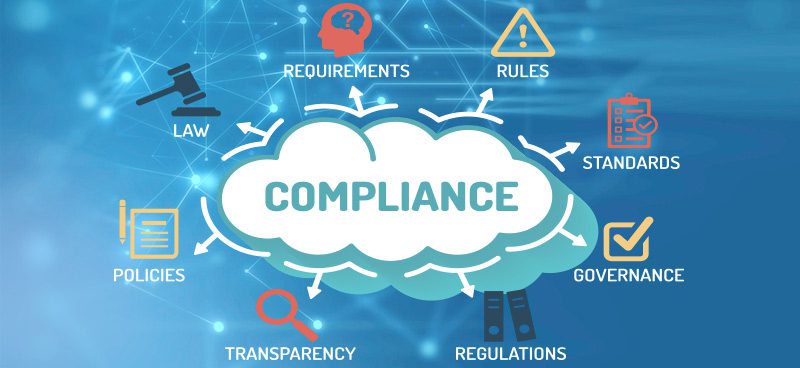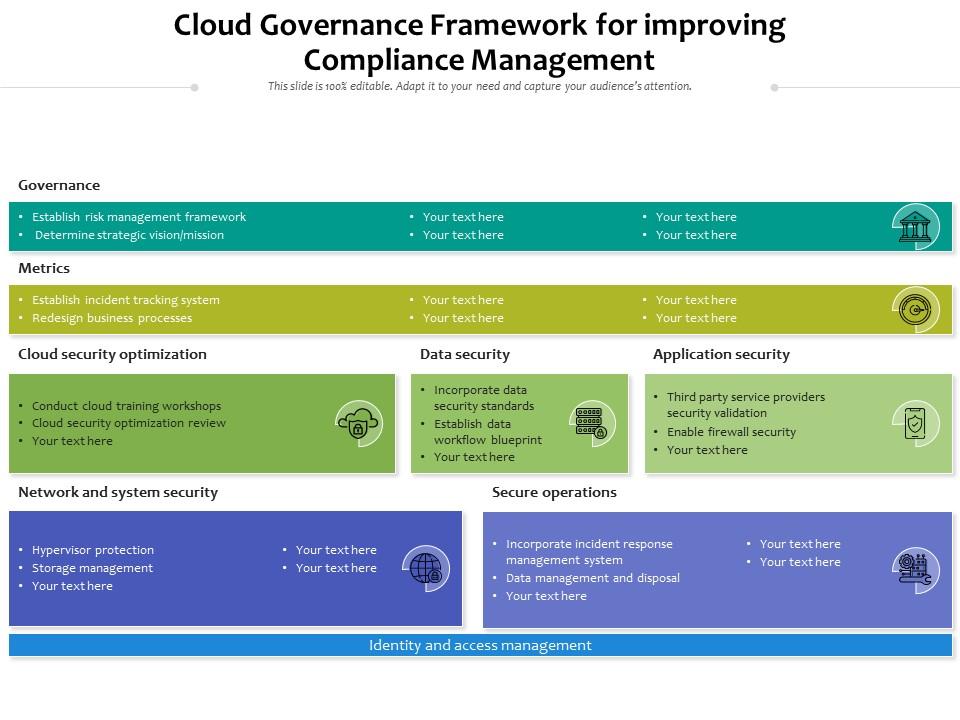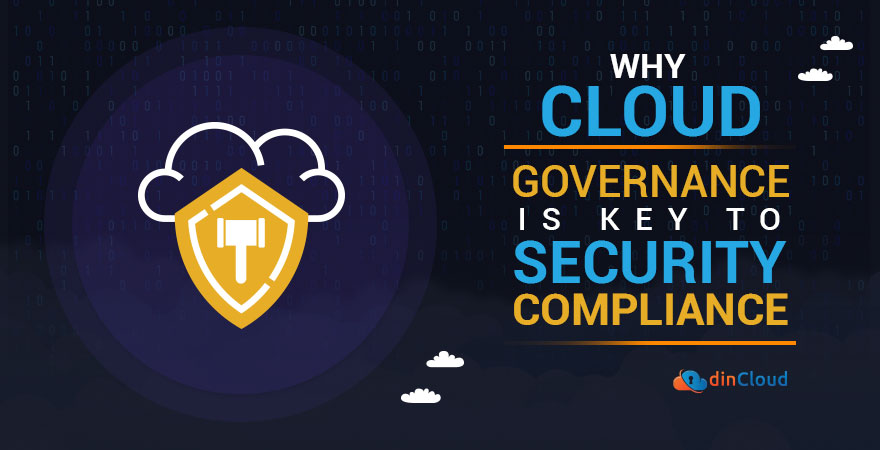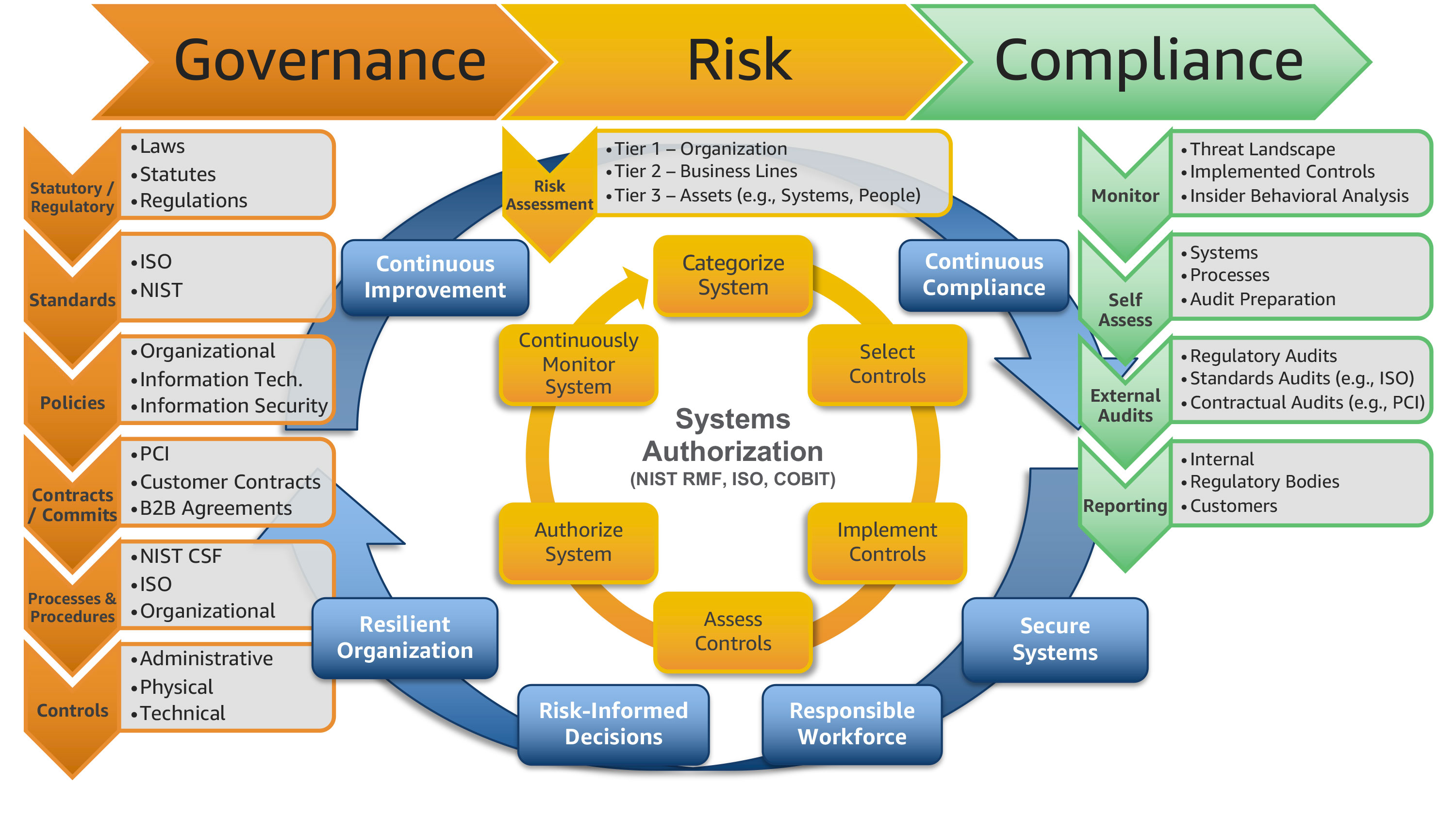The Significance of Compliance and Governance in the Cloud
Compliance and governance in the cloud are critical components of a successful cloud strategy. As organizations increasingly move their operations to the cloud, they must ensure that they adhere to various regulations and standards to protect sensitive data and maintain business continuity. Neglecting compliance and governance in the cloud can lead to significant risks, including data breaches, financial penalties, and reputational damage.
A robust compliance and governance strategy can enhance security, data protection, and business continuity. By establishing clear policies, procedures, and roles and responsibilities, organizations can ensure that their cloud environments are secure, compliant, and aligned with their business objectives. Continuous monitoring and improvement of the compliance and governance framework can help organizations stay ahead of emerging threats and regulatory changes, ensuring ongoing success in the cloud.

Key Compliance Standards and Regulations for Cloud Environments
Compliance and governance in the cloud are critical for organizations to protect sensitive data and maintain business continuity. Various regulations and standards apply to cloud environments, such as GDPR, HIPAA, and PCI DSS. Adhering to these regulations can be challenging in cloud settings due to the shared responsibility model between cloud service providers and customers.
The General Data Protection Regulation (GDPR) is a comprehensive data protection law that applies to all companies processing the personal data of EU residents. GDPR requires organizations to obtain explicit consent from individuals before collecting and processing their data, provide data subjects with access to their data, and implement appropriate technical and organizational measures to protect personal data.
The Health Insurance Portability and Accountability Act (HIPAA) is a US law that governs the use and disclosure of protected health information (PHI). HIPAA requires covered entities, such as healthcare providers and health plans, to implement administrative, physical, and technical safeguards to protect PHI. Cloud service providers that store or process PHI must also comply with HIPAA regulations.
The Payment Card Industry Data Security Standard (PCI DSS) is a set of security standards designed to ensure the safe handling of credit card information. PCI DSS applies to all entities that store, process, or transmit credit card data, including cloud service providers. Compliance with PCI DSS requires organizations to implement various security measures, such as firewalls, antivirus software, and access controls.
Non-compliance with these regulations can result in significant financial penalties and reputational damage. For example, GDPR violations can result in fines of up to 4% of global annual revenue or €20 million (whichever is greater). HIPAA violations can result in fines of up to $1.5 million per violation, while PCI DSS violations can result in fines of up to $100,000 per month.

Establishing a Robust Cloud Governance Framework
Compliance and governance in the cloud are critical for organizations to protect sensitive data and maintain business continuity. A robust cloud governance framework is essential for ensuring that cloud environments are secure, compliant, and aligned with business objectives. This framework should include policies, procedures, and roles and responsibilities that are continuously monitored and improved.
Policies are the foundation of a cloud governance framework. They should outline the organization’s approach to cloud security, compliance, and usage. Policies should be clear, concise, and accessible to all employees. They should also be regularly reviewed and updated to ensure they remain relevant and effective.
Procedures provide detailed instructions for implementing policies. They should outline the steps required to deploy and manage cloud resources securely and in compliance with relevant regulations. Procedures should be specific, measurable, and actionable. They should also be regularly reviewed and updated to ensure they remain effective.
Roles and responsibilities should be clearly defined within a cloud governance framework. Employees should understand their responsibilities for cloud security, compliance, and usage. This includes understanding their role in incident response, data protection, and access control. Clear roles and responsibilities help ensure that everyone understands their part in maintaining compliance and governance in the cloud.
Continuous monitoring is essential for ensuring the effectiveness of a cloud governance framework. Organizations should regularly review their cloud environments for vulnerabilities, misconfigurations, and compliance issues. This can be achieved through automated tools and manual reviews. Continuous monitoring helps organizations identify and address issues before they become significant problems.
Continuous improvement is also critical for maintaining a robust cloud governance framework. Organizations should regularly review and update their policies, procedures, and roles and responsibilities to ensure they remain effective. This includes staying up-to-date with changes in regulations and best practices. Continuous improvement helps organizations maintain a secure and compliant cloud environment over time.
In summary, a robust cloud governance framework is essential for ensuring compliance and governance in the cloud. Policies, procedures, and roles and responsibilities should be clearly defined and continuously monitored and improved. By taking a proactive approach to cloud governance, organizations can protect sensitive data, maintain business continuity, and ensure compliance with relevant regulations.

Implementing Cloud Compliance Tools and Solutions
As organizations move their operations to the cloud, they must ensure that they are maintaining compliance and governance in this new environment. Cloud compliance tools and solutions can help automate and streamline compliance processes, making it easier for organizations to maintain a secure and compliant cloud environment. In this article, we will discuss various cloud compliance tools and solutions and provide tips for selecting the right solution for your organization.
Cloud compliance tools and solutions can help organizations automate tasks such as monitoring for vulnerabilities, managing access controls, and maintaining audit trails. These tools can also help organizations stay up-to-date with changes in regulations and best practices, ensuring ongoing compliance. Some popular cloud compliance tools and solutions include:
- Cloud Security Posture Management (CSPM) tools: These tools help organizations monitor their cloud environments for vulnerabilities and misconfigurations, ensuring that they are maintaining a secure cloud environment.
- Cloud Access Security Brokers (CASBs): CASBs help organizations manage access controls and data protection in the cloud, ensuring that only authorized users have access to sensitive data.
- Identity and Access Management (IAM) solutions: IAM solutions help organizations manage user identities and access controls in the cloud, ensuring that only authorized users have access to cloud resources.
- Compliance Management Platforms: These platforms help organizations manage their compliance posture across multiple cloud environments, ensuring that they are maintaining compliance with relevant regulations.
When selecting a cloud compliance tool or solution, organizations should consider the following:
- Integration: The tool or solution should integrate with the organization’s existing cloud environments and tools.
- Scalability: The tool or solution should be able to scale as the organization’s cloud environment grows and evolves.
- Ease of use: The tool or solution should be easy to use and understand, with clear documentation and support.
- Cost: The tool or solution should be cost-effective, with pricing that aligns with the organization’s budget and needs.
In summary, cloud compliance tools and solutions can help organizations automate and streamline compliance processes, making it easier to maintain a secure and compliant cloud environment. When selecting a tool or solution, organizations should consider integration, scalability, ease of use, and cost. By selecting the right tool or solution, organizations can ensure ongoing compliance and governance in the cloud.

How to Develop a Cloud Compliance Strategy: Best Practices
As organizations move their operations to the cloud, they must ensure that they are maintaining compliance and governance in this new environment. Developing a robust cloud compliance strategy is essential for maintaining a secure and compliant cloud environment. In this article, we will discuss best practices for developing a cloud compliance strategy, including conducting a risk assessment, involving stakeholders, and establishing clear policies and procedures. We will also explain how to create a culture of compliance within the organization and ensure ongoing compliance through regular audits and assessments.
Conduct a Risk Assessment: The first step in developing a cloud compliance strategy is to conduct a risk assessment. This assessment should identify potential compliance risks and vulnerabilities in the organization’s cloud environment. The assessment should also prioritize these risks based on their potential impact and likelihood of occurrence. This information can then be used to develop a compliance strategy that addresses these risks and vulnerabilities.
Involve Stakeholders: Developing a cloud compliance strategy is a collaborative effort that requires the involvement of stakeholders from across the organization. This includes IT staff, legal counsel, and business leaders. By involving stakeholders in the development process, organizations can ensure that the compliance strategy aligns with business objectives and is supported by all relevant parties.
Establish Clear Policies and Procedures: A cloud compliance strategy should include clear policies and procedures for maintaining compliance in the cloud. These policies and procedures should cover topics such as data privacy, access controls, and audit trails. They should also be regularly reviewed and updated to ensure that they remain relevant and effective.
Create a Culture of Compliance: Creating a culture of compliance within the organization is essential for ensuring ongoing compliance in the cloud. This can be achieved by providing training and education to employees, establishing clear policies and procedures, and promoting a culture of accountability and transparency. By creating a culture of compliance, organizations can ensure that all employees understand their role in maintaining compliance and are committed to following established policies and procedures.
Ensure Ongoing Compliance through Regular Audits and Assessments: Regular audits and assessments are essential for ensuring ongoing compliance in the cloud. These audits should be conducted by both internal and external auditors and should cover all aspects of the organization’s cloud environment. The results of these audits should be used to identify areas for improvement and to ensure that the compliance strategy remains effective.
In summary, developing a robust cloud compliance strategy is essential for maintaining a secure and compliant cloud environment. Best practices for developing a cloud compliance strategy include conducting a risk assessment, involving stakeholders, establishing clear policies and procedures, creating a culture of compliance, and ensuring ongoing compliance through regular audits and assessments. By following these best practices, organizations can ensure that they are maintaining compliance and governance in the cloud and avoiding the potential risks and consequences of non-compliance.

Addressing Common Cloud Compliance Challenges
As organizations move their operations to the cloud, they face a number of challenges when it comes to maintaining compliance and governance. Some of the most common challenges include data privacy, access control, and audit trails. In this article, we will discuss these challenges and provide practical solutions and strategies for addressing them and ensuring ongoing compliance and governance in the cloud.
Data Privacy: One of the biggest challenges when it comes to cloud compliance is ensuring the privacy of sensitive data. This is particularly important in light of regulations such as the General Data Protection Regulation (GDPR), which requires organizations to protect the personal data of EU citizens. To address this challenge, organizations should implement robust data protection measures, such as encryption and access controls, to ensure that sensitive data is protected both in transit and at rest. They should also establish clear policies and procedures for data handling and ensure that all employees are trained on these policies.
Access Control: Another common challenge when it comes to cloud compliance is ensuring appropriate access controls. This is particularly important in cloud environments, where multiple users and applications may have access to the same data and resources. To address this challenge, organizations should implement strong access controls, such as multi-factor authentication and role-based access control, to ensure that only authorized users have access to sensitive data and resources. They should also regularly review and audit access controls to ensure that they are effective and up-to-date.
Audit Trails: Maintaining accurate and complete audit trails is essential for ensuring cloud compliance. This is particularly important in the event of a security breach or compliance audit. To address this challenge, organizations should implement robust audit trail capabilities, such as logging and monitoring, to ensure that all activity in the cloud environment is tracked and auditable. They should also establish clear policies and procedures for audit trail management and ensure that all employees are trained on these policies.
In summary, organizations face a number of challenges when it comes to maintaining compliance and governance in the cloud. These challenges include data privacy, access control, and audit trails. By implementing robust data protection measures, strong access controls, and robust audit trail capabilities, organizations can address these challenges and ensure ongoing compliance and governance in the cloud. By following these best practices, organizations can ensure that they are maintaining compliance and governance in the cloud and avoiding the potential risks and consequences of non-compliance.

The Role of Cloud Service Providers in Compliance and Governance
As organizations move their operations to the cloud, they often rely on cloud service providers (CSPs) to manage and maintain their cloud environments. However, it is important for organizations to understand that CSPs play a critical role in ensuring compliance and governance in the cloud. In this article, we will discuss the role of CSPs in compliance and governance, and provide guidance on how to evaluate CSPs’ compliance capabilities and establish clear service level agreements (SLAs) and expectations.
Understanding the Role of CSPs: CSPs are responsible for providing and managing the underlying infrastructure and services that support an organization’s cloud environment. This includes ensuring the availability, security, and performance of the cloud environment. As such, CSPs play a critical role in ensuring compliance and governance in the cloud. They are responsible for implementing and maintaining the necessary controls and processes to meet the compliance requirements of their customers. It is important for organizations to understand the role of CSPs in compliance and governance, and to ensure that their CSPs have the necessary capabilities and processes in place to meet their compliance needs.
Evaluating CSPs’ Compliance Capabilities: When selecting a CSP, organizations should evaluate the CSP’s compliance capabilities to ensure that they align with their own compliance requirements. This includes reviewing the CSP’s compliance certifications, such as SOC 1, SOC 2, and ISO 27001, as well as their compliance with specific regulations, such as GDPR, HIPAA, and PCI DSS. Organizations should also review the CSP’s policies, procedures, and controls to ensure that they are robust and effective. Additionally, organizations should consider the CSP’s track record in maintaining compliance and their ability to provide evidence of their compliance efforts.
Establishing Clear SLAs and Expectations: Once an organization has selected a CSP, it is important to establish clear SLAs and expectations around compliance and governance. This includes defining the specific compliance requirements that the CSP must meet, as well as the processes and procedures for monitoring and reporting on compliance. Organizations should also establish regular communication channels with the CSP to ensure that any issues or concerns are addressed in a timely and effective manner. By establishing clear SLAs and expectations, organizations can ensure that their CSPs are meeting their compliance needs and that they are able to maintain ongoing compliance and governance in the cloud.
In summary, CSPs play a critical role in ensuring compliance and governance in the cloud. Organizations should evaluate CSPs’ compliance capabilities and establish clear SLAs and expectations to ensure that their CSPs are meeting their compliance needs. By following these best practices, organizations can ensure that they are maintaining compliance and governance in the cloud and avoiding the potential risks and consequences of non-compliance.

Measuring the Effectiveness of Cloud Compliance and Governance
As organizations continue to adopt cloud technologies, it is essential to establish robust compliance and governance frameworks to ensure the security, data protection, and business continuity of their cloud environments. However, simply implementing these frameworks is not enough. It is equally important to measure the effectiveness of these efforts to ensure ongoing success. In this article, we will discuss how to measure the effectiveness of cloud compliance and governance efforts, including key performance indicators (KPIs) and metrics to track.
Defining KPIs and Metrics: The first step in measuring the effectiveness of cloud compliance and governance is to define KPIs and metrics that align with the organization’s business objectives. These KPIs and metrics should be specific, measurable, achievable, relevant, and time-bound (SMART) to ensure that they provide meaningful insights into the organization’s compliance and governance efforts. Examples of KPIs and metrics for cloud compliance and governance include the number of compliance violations, the time to resolve compliance issues, the percentage of data that is encrypted, and the availability and performance of the cloud environment.
Tracking and Reporting: Once KPIs and metrics have been defined, it is important to establish processes for tracking and reporting on these metrics. This includes collecting and analyzing data from various sources, such as cloud service providers, compliance tools, and internal systems. Organizations should also establish regular reporting cadences to ensure that stakeholders are informed of the organization’s compliance and governance performance. These reports should be easy to understand and provide actionable insights into areas for improvement.
Continuous Improvement: Measuring the effectiveness of cloud compliance and governance is not a one-time activity. It is an ongoing process that requires continuous monitoring and improvement. Organizations should regularly review their KPIs and metrics to identify areas for improvement and make adjustments to their compliance and governance frameworks as needed. This includes updating policies and procedures, implementing new tools and solutions, and providing training and awareness programs for employees.
In summary, measuring the effectiveness of cloud compliance and governance efforts is critical to ensuring the security, data protection, and business continuity of cloud environments. By defining KPIs and metrics, tracking and reporting on these metrics, and continuously improving their compliance and governance frameworks, organizations can ensure ongoing success in their cloud compliance and governance efforts. By following these best practices, organizations can maintain compliance and governance in the cloud and avoid the potential risks and consequences of non-compliance.

